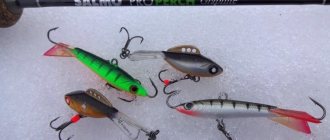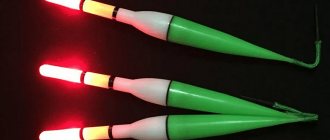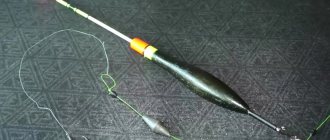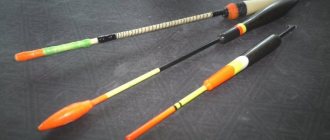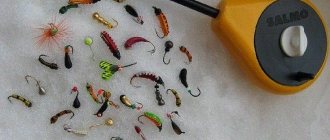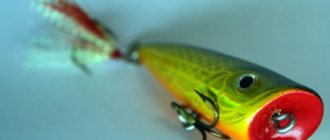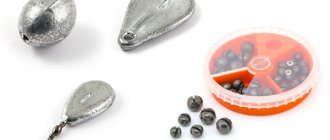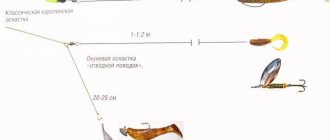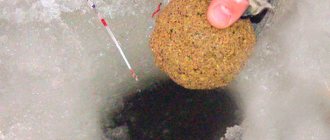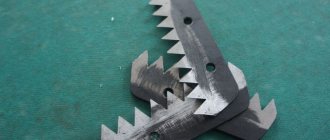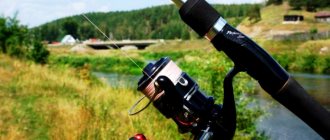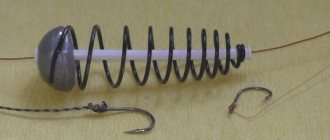As a matter of fact, the definition of “float fishing rod” implies in its equipment such an element as a float. Moreover, this element of equipment occupies, if not the main, then, of course, key importance directly in catching this or that fish. Today, the fishing accessories market offers both beginners and professional fishermen a huge selection of floats - different shapes, sizes, colors, as well as the location of individual elements. And, of course, the materials from which they are made. Today 34fish.ru will help you understand all the diversity.
What parts does the float consist of?
There are different types of installation of floats directly to the common chain of elements, of which the most common is the so-called “blind” equipment.
The float, designed for “blind” equipment, consists of four elements, which have the following names:
- body;
- keel;
- antenna;
- top ring.
So, let's take a closer look at them, since the final result of fishing will depend on the correct choice of float.
We also recommend reading:
How to properly tie a jig to a fishing line Diagram on how to learn how to tie a hook to a fishing line Tourist knots - types and methods of tying Gardner's loop for a feeder: how to tie
Homemade floats for catching crucian carp
One of the best floats is a goose feather. It is an excellent device for fishing and is a good replacement for expensive similar devices. Making such a float is not difficult.
You just need to get a goose feather. By the way, a lot of these feathers lie on the ground after bazaars and markets, as well as in pet stores. In order to bring the feather into the form of a float, it must be cleaned of feathers.
This is done using a knife or scissors. After that, a mark is placed on the top of the float, which will act as a tip. This can be done with an ordinary alcohol marker. A nipple with fishing line is attached to the lower end of the feather.
Gallery: fishing floats (25 photos)
Materials from which float keels are made and their effect on the general characteristics of the float
The three main elements of a float are the antenna, body and keel. When choosing a float for fishing, it is a good idea to know how these elements of the float affect its characteristics and sensitivity.
Float antenna.
One of the requirements for a float is that it must be visible in all fishing situations (against the sun, waves, rain, wind) so that you can make an effective hook as soon as you see a bite.
The visibility of the float primarily depends on the antenna, the main task of which is to signal a bite. The antenna must be clearly visible and at the same time have low windage and good sensitivity. In order for the bite to be clearly realized, the fish should not feel the resistance of the float when it takes the bait.
The ideal compromise is achieved by using an antenna that matches the fishing conditions and the type of fish. The choice of antenna depends on the state of the water and lighting during fishing.
- change the color of the antenna using special paint;
- paint the antenna with fluorescent paint or make it thinner in order to put on a fluorescent plastic tube;
- use floats with replaceable antennas;
- use replaceable hollow antennas.
The visibility and sensitivity of the float depends not only on the shape of the antenna, but also on the material from which it is made.
Topless. A float without an antenna (the so-called Dibber) is lightly weighted, only surface tension keeps its tip above the water. The Dibber is very visible thanks to its wide head. Such floats are suitable for use with bulky baits, such as corn, and for catching large fish such as carp, which bite quite sharply and accurately.
Heavy steel. In good light conditions, floats with a steel antenna are unsurpassed. They note not only quick bites, but also careful tugging of the bait. But steel antennas are difficult to see in strong backlight because the sun does not shine through the steel. The antenna's carrying capacity is negative due to the material. Therefore, floats with steel antennas require a very thin weight.
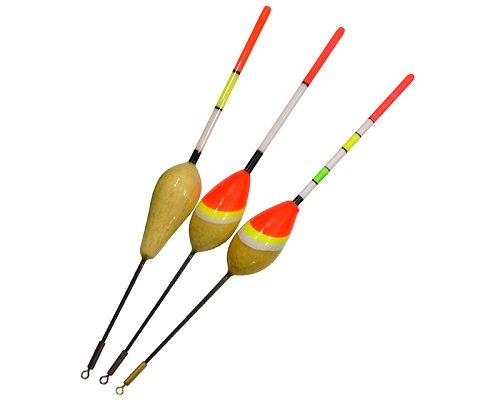
Light fiberglass. Fiberglass antennas are more visible in low light conditions than steel ones. Fiberglass allows the sun's rays to pass through it, so antennas made from it have a fluorescent glow effect. Such a float clearly reacts to the slightest touch of a fish on the bait. But it works well only in calm water, and on a wave it fluctuates, simulating false bites.
Stable plastic. Plastic antennas are best visible: in windy weather and during waves. Floats with such antennas are very stable, easy to load, and they respond well to bites. But sometimes these antennas are difficult to see due to their small diameter.
Hollow plastic. Hollow plastic antennas are clearly visible due to their large diameter. Even in low light they guarantee good bite recognition. Replacing large baits with small ones does not greatly affect the position of the antenna. The price you have to pay for this is that the antenna does not detect bites so sensitively.
Floating bamboo. Bamboo antennas have excellent load-carrying capacity. Floats with such antennas are good when the fish takes the bait in the falling phase. In strong waves and wind, the bamboo antenna reduces the swaying of the float's body and is always ready to signal a bite. But due to its high buoyancy, it is not very sensitive.
The keels of floats, like antennas, are made of various materials, which also affect the behavior of the float.
The steel keel, due to its mass, stably holds the float vertically on the water, even in the wind. In a current, a steel keel has less resistance to water than keels made of other materials. A steel keel allows you to use small floats with a lightweight body and antenna. This real advantage manifests itself when ultra-delicate fishing is required.
Fiberglass keels are very hard and durable. Floats with keels made of this material are used primarily for Bolognese and carp fishing, where a very durable, unpretentious float is required that can experience heavy loads.
Bamboo keels are very light and have a high load capacity, so they are used for fishing when the float has to withstand a significant influence of the weight of the sinker and bait. Floats with a bamboo keel are also good for fishing with slowly falling bait in the middle layers of water.
The keels of carbon fiber floats work well when the bait is strictly vertical under the float. This type of keel material is used in deep reservoirs without a current or when fishing for line fishing in channels with very weak currents. In strong currents or windy conditions, floats with carbon fiber keels, on the contrary, spin in one place and do not respond very accurately to bites.
What should the keel be like?
The stability of the float is ensured by its element, such as the keel. They come in different sizes and are made from carbon fiberglass or metal. Moreover, as experience in using floats made from this material has shown, they should be used in the following conditions:
- A long keel made of metal is best suited for large floats that are designed for fishing from the bottom.
- In shallow waters, when fishing at shallow depths, it is more reliable to use floats with plastic keels, as they are more sensitive to bites and are also less susceptible to tangling of the fishing line.
On the lower and upper parts of the keel, two cambrics are placed, for which the float is attached to the main fishing line.
Fishing in shallow waters
A transparent float is ideal for catching a wide variety of fish in shallow waters - crucian carp, carp, tench, bream, ide, chub and many others. Such a float is especially effective in autumn and early spring, when almost all the fish rush to warm shallow waters, with the exception of some cold-loving renegades like burbot. But the spring (autumn) fish feast is a conditional and periodic concept. And even at this time in the shallows, fish of decent size remain extremely cautious. It is in such conditions that I never use heavy and bright floats - the former will splash heavily on the water, the latter can scare away the fish with their appearance. Therefore, I put floats of gray and bluish colors, and even more often transparent. And definitely light, lying on the water like a goose feather float - almost silently, exemplary for the most modern expensive float alarm.
Read: How to attach equipment to a fishing rod?
Float antenna
The purpose of this element in the float is, of course, to signal a bite. As a result, the float antenna should be clearly visible at relatively long distances and, of course, in any weather!
Antenna shapes can also be varied:
- Long and thin antennas are made of fiberglass or metal. They perfectly inform the angler about even the most cautious bite, but are poorly distinguishable from a distance, and they also show some instability in strong winds or currents.
- Short and thick antennas are made of feather, plastic, or wood. They behave well in bad weather conditions, but they only react to a bite by going completely under the water or, conversely, lying on the surface of the reservoir. Careful fish bites will be invisible.
How the fish looks
It’s worth looking at the topic of float camouflage much more broadly, not limiting ourselves to transparency, because most floats both in stores and in our already formed float arsenals are very visible, often too much so. What for?! Okay, an antenna, good visibility of which is vital for us to control the fishing process. But most of the loaded float is under water, and it is watched by the fish, not the fisherman. I once had a large set of floats - waglers made of goose and other feathers, covered with various camouflage color options, both matte and not shiny: dirty brown and black with some kind of knot, camouflage colors with blurry transitions of dirty gray and brown tones. It would seem that if you throw one of these on the water, you’d never be able to tell that it’s a float – it’s like something natural, familiar to fish, is floating. But one day, on a sunny, warm day, I dived under the boats stacked on the pier, and was surprised to notice that the black bottom of the boat was much more noticeable than the white one - there was only one snow-white “Kazanka” standing there. This is the answer, because the fish looks at our float not from above, but from below, and sees it against the sky. This means that the best color of the float is neither black, nor green, nor, especially, bright yellow or red, but blue and gray of various shades characteristic of the sky above our heads. This was a long time ago, and since then I have repeatedly been convinced of the correctness of this conclusion when fishing in shallow waters and in clear water, where a bright float often scares away fish, especially large ones, and attracts only outright small things, which is bad, because stupid fry often just “butt” the float itself, especially the bleak.
Most of the store floats, designed specifically for fishing in shallow waters, are painted to look like a “parrot”, and the purpose of such coloring is one - to please the buyer’s eye. The only good option for coloring the bottom of branded floats seems to be white, and I think this is a smart move by manufacturers of branded items: relative camouflage is maintained, and the float remains elegant, if this is important for someone. As for the appearance in float fishing of a transparent plastic float, in which only the antenna is colored (you need to see the bites), this is a logical continuation of the theme of camouflage.
Read: How to fish correctly with a fly rod
Pay attention to the top ring
In the upper part of the “body” of the float there is a small ring through which the main fishing line is passed, and it is intended for its stability during any kind of movement. It is usually made from thin wire or plastic. Well, this ring is placed closer to the center of the sail of the float, so that in the wind and current it always maintains its vertical position. A ring located in the upper part of the “body” of the float, in close proximity to its antenna, is the best option during any fishing! We recommend that you familiarize yourself with the material on loading a float.
Correct loading of the float on crucian carp
Choosing the right float is half the battle when fishing for crucian carp. The main point in fishing is a properly loaded float.
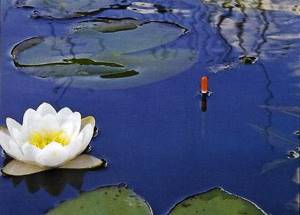
Ideally, a float is considered correctly loaded if only its tip is visible from under the water. In this case, fishing will give you more joy and pleasant emotions.
In order to properly load a float at home, you need to know the mass of the float. Knowing the mass, you can easily find out which sinkers to hang on the fishing line.
In order to hang them, you need to have small pliers that can be used to clamp the sinkers on the fishing line. To check that your float is properly loaded, you need a bucket of water or a barrel. Dip the float with the equipment into a container filled with water. If the float stays afloat in a vertical position, then your shipment is correct.
If the float is displaced from the vertical position, or gradually sinks into the water, then it is necessary to add or reduce the weight of the sinker.
